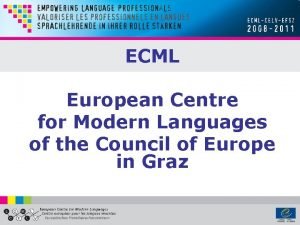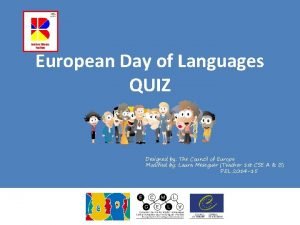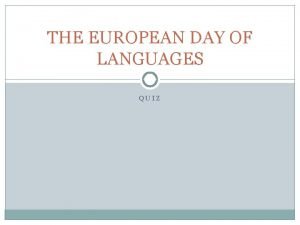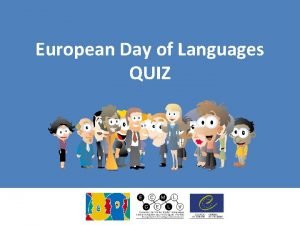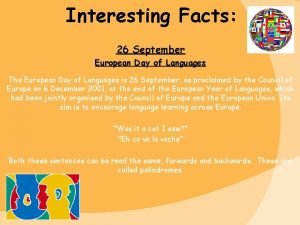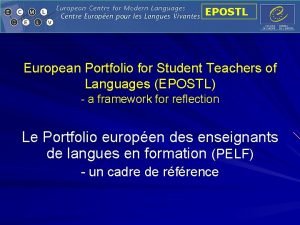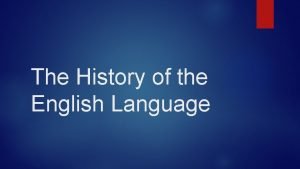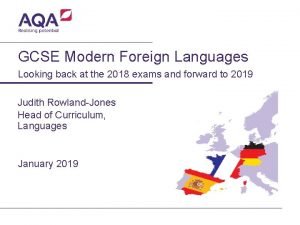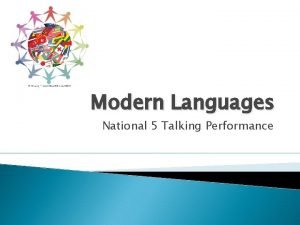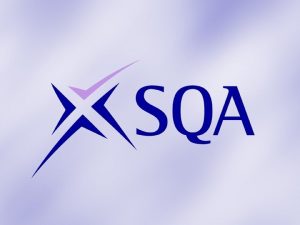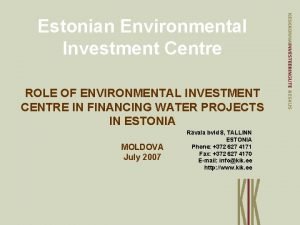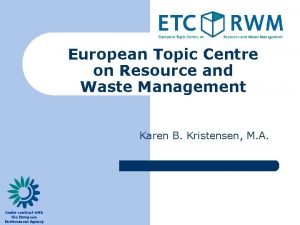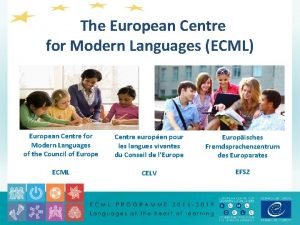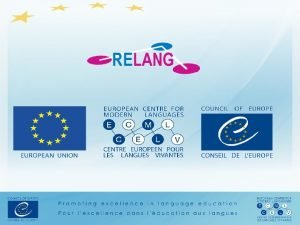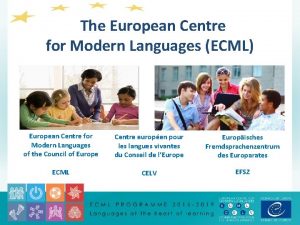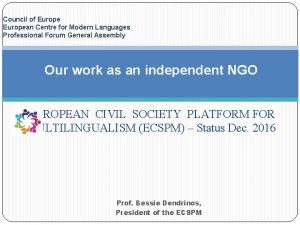The European Centre for Modern Languages of the














- Slides: 14

The European Centre for Modern Languages of the Council of Europe Language Learning Pathways: Some reflections on assessment

Three fundamentals • Within a Council of Europe perspective, the assessment of language proficiency should – never be used to infringe the human rights of the individual – always seek to gauge learners’ communicative proficiency and not, e. g. , test their knowledge of target language grammar – use the descriptive scheme and proficiency levels of the CEFR in a coherent and transparent way

The challenge of the CEFR • The CEFR challenges us to develop a language education culture in which learning and assessment are inseparable: two sides of the same coin • This challenge derives from the CEFR’s action-oriented approach and the fact that each “can do” descriptor can be used simultaneously to – specify a learning outcome – provide a learning focus – imply an assessment task • Learners themselves can participate fully in this educational culture because the CEFR’s primary focus is behavioural and from early childhood we know what we can do • The ELP was conceived as a way of sharing the CEFR’s ethos and approach with learners and enabling them to manage their own language learning on the basis of reflection driven by self-assessment

CEFR as a tool of “constructive alignment” • “Constructive alignment”: coherence between intended learning outcomes, teaching/learning, and assessment • The CEFR is a tool of constructive alignment when its descriptive scheme and proficiency levels are used to – define the outcomes we want our learners to achieve – design the tasks and criteria by which learning achievement will be assessed – develop approaches to teaching that engage learners in activities that will help them achieve the intended outcomes • Self-assessment is a matter of understanding what, how and how well one has learned; it plays a central role in all reflective learning • A capacity for accurate self-assessment is central to effective lifelong learning

The European Language Portfolio • According to the Principles and Guidelines, a key function of the ELP is to promote learner autonomy by helping learners to manage their own learning • It includes the learning and use of all the languages in the learner’s repertoire, including those that are not part of the curriculum • It is thus intended to accompany and document non-formal as well as formal language learning • In its documentary function it records the learning pathways that the learner has trodden to date • In its pedagogical function it helps learners to plan and manage their learning as they set out on new pathways

The ELP and self-assessment • Each ELP includes checklists of “I can” descriptors organized according to the communicative language activities and proficiency levels of the CEFR • The CEFR defines language learning as a variety of language use: each “I can” descriptor is part of an autonomous language user’s self-portrait • The ELP and learner autonomy: each “I can” descriptor is part of an autonomous language learner’s self-portrait • In an autonomy-oriented, learner-co-directed classroom, selfassessment has two complementary dimensions – Individual (in each learner’s ELP) – Communal (the self-assessment of the class as a whole)

Self-assessment in action • Consider sample descriptors from each of the CEFR levels: A 1: I can introduce somebody and use basic greeting and leave-taking expressions A 2: I can make simple transactions in shops, post offices or banks B 1: I can start, maintain and close simple face-to-face conversation on topics that are familiar or of personal interest B 2: I can initiate, maintain and end discourse naturally with effective turntaking C 1: I can use the language fluently, accurately and effectively on a wide range of general, professional or academic topics C 2: I can take part effortlessly in all conversations and discussions with native speakers

Self-assessment in action • A 1 descriptors refer to discrete tasks • A 2 descriptors refer to transactional and interactional routines • From B 1 upwards descriptors refer to increasingly general and complex communicative activity • Thus at levels B 1, B 2, C 1 and C 2 descriptors – cannot be adopted as short-term learning goals – must be used to frame the reflective processes of planning, monitoring and evaluating learning – must be deconstructed into short-term and intermediate learning goals

Interpreting descriptors − Example 1 B 2 reading • I can quickly scan through long and complex texts on a variety of topics in my field to locate relevant details – – – How quickly is “quickly”? What is “my field”? What is an appropriate “variety of topics”? In terms of field and topics, what counts as a “long and complex text”? What count as “relevant details”

Interpreting descriptors − Example 2 B 2 writing • I can write clear detailed text on a wide range of subjects relating to my personal, academic or professional interests – What are “my academic and/or professional interests”? – What is an appropriate “range of subjects”? – How do we define “clear detailed text”?

Getting the most out of self-assessment • In the autonomy-oriented, learner-co-directed classroom, selfassessment is just one part of the reflective cycle • Reflection is internalized from interaction – Self-assessment should be embedded in class/group discussion – Self-assessment should interact with peer assessment • Self-assessment should never be a matter of simply ticking boxes: learners should always be required to provide support for their claims

Example from a Czech primary school (A 1) • On the classroom wall: a large drawing of a tree • Five main branches: LISTENING, READING, SPOKEN INTERACTION, SPOKEN PRODUCTION, WRITING • On each of the main branches, a smaller branch for each descriptor • A box of paper leaves • When they wished to make a self-assessment claim, learners wrote their name on a leaf and stuck it on the appropriate branch • When the teacher or one of their peers was satisfied that the claim was justified, he/she countersigned the leaf, which the learner coloured green

Some points for reflection/discussion • Can you think of any ways in which the assessment of language proficiency might infringe the individual’s human rights? • How exactly would you use the CEFR as a tool of constructive alignment in your context? • In your context, how would you integrate self- and peer-assessment with school-based assessment and external exams? • With learning pathways and assessment in mind, do you see a role for the ELP in the future development of language education in your context? – If yes, how would you use the ELP in the classroom to support the processes of constructive alignment? – If no, what instruments would you use to help learners to take control of their own learning?

Task for group work In addressing the issues and responding to the challenges that have been identified, how could we make use of • the Council of Europe’s enlarged understanding of mediation? • the five levels of educational activity covered by policy: supra, macro, meso, micro, nano? • reflective learning supported by CEFR/ELP-related self -assessment?
 European center for modern languages
European center for modern languages European center for modern languages
European center for modern languages European day of languages quiz
European day of languages quiz European day of languages quiz
European day of languages quiz Fisker frits fisker friske fisk
Fisker frits fisker friske fisk European day of languages facts
European day of languages facts Epostl
Epostl Characteristics of indo european languages
Characteristics of indo european languages Defence centre for languages and culture
Defence centre for languages and culture Gcse modern foreign languages
Gcse modern foreign languages National 5 modern languages talking performance
National 5 modern languages talking performance Modern languages for life and work
Modern languages for life and work Eic european investment centre
Eic european investment centre European topic centre
European topic centre European centre for disease prevention and control
European centre for disease prevention and control

